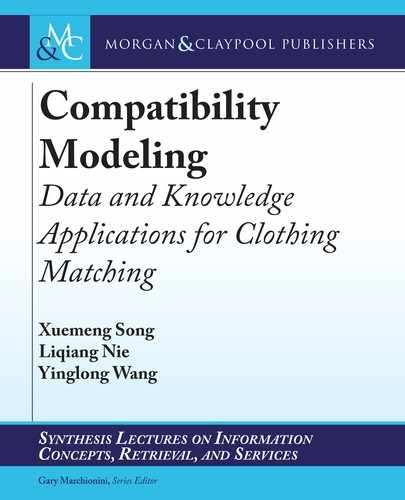
76 6. PERSONALIZED COMPATIBILITY MODELING
compatibility score, we generated a ranking list of these bottoms for each query. In our setting,
we focused on the average position of the positive bottom in the ranking list and thus adopted
the MRR metric [52, 128, 129].
Figure 6.7 shows the performance of different models in terms of MRR at different num-
bers of the bottom candidates T . As can be seen, our GP-BPR shows superiority over all the
other baselines consistently at different numbers of bottom candidates, demonstrating the ef-
fectiveness of our model in the personalized complementary fashion item retrieval. Moreover,
to get a better understanding of our GP-BPR in this context, in Figure 6.8, we listed the rank-
ing results of GP-BPR and its derivatives G-BPR and P-BPR for a given query. For the query
“red knit pullover,” G-BPR that simply relies on the general compatibility modeling, does rank
the compatible bottoms at first places, including the positive one. en further taking the user
(historical) preference factor into account, we found that GP-BPR can boost the rank of the
positive bottom from the fourth place to the first one, which verifies the importance of the user
factor.
0.7
0.6
0.5
0.4
0.3
0.2
0.1
0.0
10 20 30 40 50 60 70 80 90 100
RAND
Bi-LSTM
BPR-DAE
BPR-MF
VBPR
TBPR
VTBPR
GP-BPR
MRR
T
Figure 6.7: Performance of different approaches with respect to MRR at different numbers of
the bottom candidates T .
6.5 SUMMARY
In this chapter, we present a personalized compatibility modeling scheme toward personalized
clothing matching, termed GP-BPR, which measures the compatibility between fashion items
from not only the general aesthetics but also the personal preference perspectives. In particular,
motivated by the fact that both modalities (i.e., the visual and contextual modalities) of fashion
items can deliver valuable information regarding personal preference, we integrate the visual and
contextual data of fashion items into the personal preference modeling. Extensive experiments

6.5. SUMMARY 77
Query
Rank List
1 2 3 4 5 6 7 8 9 10
Top
User Historical
Preference
G-BPRP-BPRGP-BPR
Figure 6.8: Illustration of the ranking results. e bottoms highlighted in the red boxes are the
positive ones.
have been conducted on the created Dataset II. e encouraging experiment results verify the
effectiveness of the proposed scheme and indicate the necessity of integrating both the gen-
eral item-item compatibility and personal user-item preference in the context of personalized
clothing matching. One limitation of our work is that currently we fuse the two components
of general compatibility modeling and personalized preference modeling linearly. In the future,
we plan to devise a more advanced fusion strategy, such as the attentive fusion, to boost the
performance.
..................Content has been hidden....................
You can't read the all page of ebook, please click here login for view all page.
